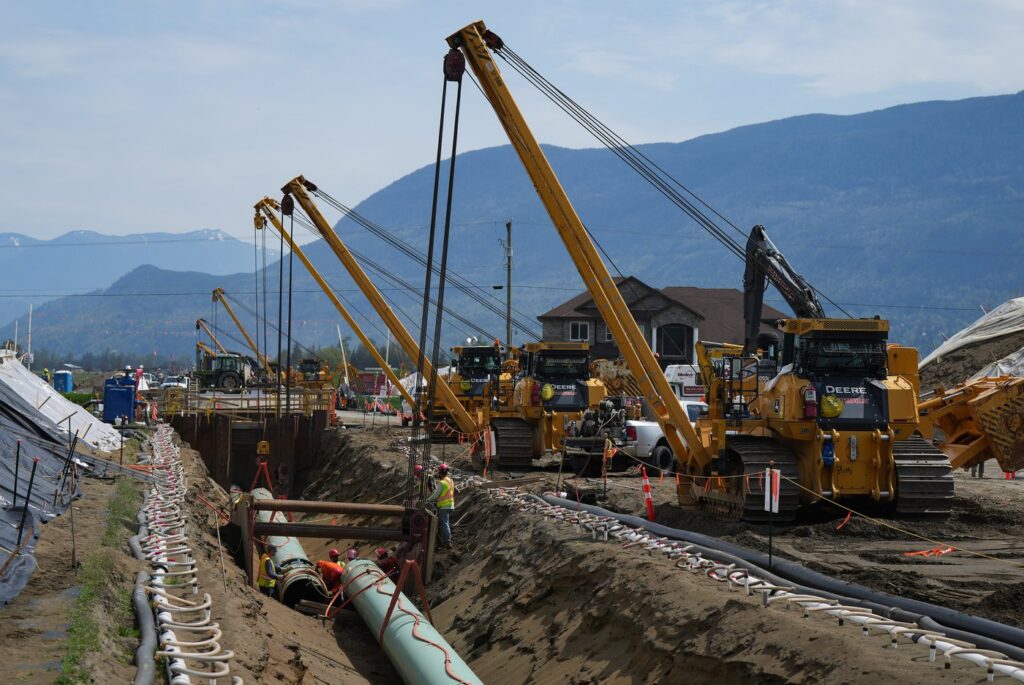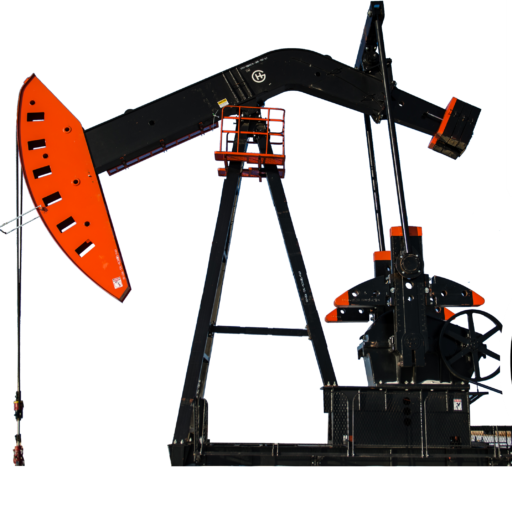
Workers lay pipe during construction of the Trans Mountain pipeline expansion, in Abbotsford, B.C., on Wednesday, May 3, 2023. The company building the expansion is still working to find a solution for its latest unexpected construction challenge in B.C. THE CANADIAN PRESS/Darryl Dyck
The company building the Trans Mountain pipeline expansion continues to work to find a solution for its latest unexpected construction challenge in B.C.
Crown corporation Trans Mountain Corp. is currently removing the section of pipe it had been attempting to pull into the hole drilled for it in the Fraser Valley between Hope and Chilliwack.
The company had been using an engineering technique referred to as horizontal directional drilling for that section, but announced on Monday it had encountered what it called “technical issues.”
On Wednesday, a company spokesperson said the problems were related to an obstruction discovered while attempting to pull the pipe into the hole, and that it is now assessing options to remove it.
The Canada Energy Regulator said it is aware of Trans Mountain’s latest challenges, and has inspection officers on site as part of standard compliance verification activities.
“No safety or environmental concerns have been noted, and we will continue to monitor the situation,” the regulator said in a news release.
The Trans Mountain pipeline is Canada’s only oil pipeline to the West Coast and its expansion will increase the pipeline’s capacity to 890,000 barrels per day from 300,000 bpd currently. Construction is already 98 per cent complete.
But the company has been racing against the clock as it deals with a variety of difficulties related to hard rock and challenging terrain. The latest challenges are expected to push the pipeline’s in-service date back from the first quarter to the second quarter of this year.
Horizontal directional drilling is a method of pipeline installation that can be used instead of traditional open-trench methods. It can be used to install pipe under a body of water or in ecologically sensitive terrain where surface disturbances must be minimized.
The process involves drilling a horizontal borehole from point A to point B, below any surface-level obstacles, and then pulling the pipe through the hole from Point B to Point A to install it.
But according to testimony by Trans Mountain at a regulatory hearing in January, the company encountered hard rock conditions while drilling the borehole that resulted in multiple fractured areas within the bedrock. As a result, water began entering the hole, and the company was fearful that if it kept drilling, the entire borehole could be compromised.
If that happened, the company would need to come up with an entirely new installation plan for that section of pipe — a “catastrophic” outcome that would delay the project’s completion by approximately two years, and result in Trans Mountain losing billions of dollars in oil shipping revenues.
That’s why Trans Mountain requested, and was ultimately granted, permission from the regulator to change the size, thickness and coating of a 2.3-kilometre stretch of pipe. Using a smaller pipe would allow the company to stop drilling and work with the size of hole it already had, rather than keep trying to widen the hole and risk it failing.
Trans Mountain said at the time of the regulatory hearing that using a smaller-diameter pipe would have a high likelihood of succeeding, since the borehole would require no more drilling and the pipe was also already on site, ready to be pulled into place.
But Janaka Ruwanpura, an engineering professor and project management expert at the University of Calgary, said there are always risks that the unexpected will happen, particularly when working in mountainous terrain.
“Constructing a large-scale project like Trans Mountain presents really big challenges, both anticipated and unforeseen,” he said.
“The complexities stem from unique and often harsh conditions within the mountain environment.”
While horizontal directional drilling is a common, proven and popular method of pipeline installation, Ruwanpura said, it also poses some inherent risks. Engineers design horizontal directional drilling projects based on their understanding of geology and sub-surface conditions, but surprises do happen.
“It’s possible that with all the due diligence you do, there could be uncertainties that you still don’t know, because it’s underground construction,” he said.
“You don’t have the luxury of doing soil sampling in every single place (along the line). You’re doing it between two places and then you’re making an educated assumption.”
Ruwanpura said every unexpected challenge Trans Mountain encounters at this point has the potential to increase costs and delay the pipeline’s start-up date. But he said an important part of project management is knowing how to remain calm.
“What’s important (for them) now is not to panic,” he said. “When you deal with a crisis situation like this, it’s important not to panic and to instead come up with a sustainable plan to get out of it.”
According to the American Petroleum Institute, horizontal directional drilling is an important tool in pipeline construction, but not appropriate for every design situation and geotechnical condition.
“As with any subsurface construction method, unknown or unforeseen conditions may be encountered,” the API states.
The Trans Mountain pipeline is owned by the federal government, which purchased it in 2018 in an effort to get the expansion project over the finish line after it was scuttled by previous owner Kinder Morgan Canada.
The project’s costs have spiralled through the course of construction from an original estimate of $5.4 billion to the most recent estimate of $30.9 billion.
This report by The Canadian Press was first published Feb. 1, 2024.
- 0098 SASPO-2874_Self Serve Campaign_New Connects_Youtube_v30098 SASPO-2874_Self Serve Campaign_New Connects_Youtube_v3
- 0100 Turnbull Project Manager0100 Turnbull Project Manager
- 0099 Mryglod Steel 1080p0099 Mryglod Steel 1080p
- 0097 Eagle Sky Ventures LTD0097 Eagle Sky Ventures LTD
- 0095 Fast Trucking nearly 70 years good at it0095 Fast Trucking nearly 70 years good at it
- 0053 Kingston Midstream Westspur Alameda Click Before You Dig0053 Kingston Midstream Westspur Alameda Click Before You Dig
- 0092 Turnbull projects big and small0092 Turnbull projects big and small
- 0046 City of Estevan This is Estevan Teaser0046 City of Estevan This is Estevan Teaser
- 0087 Lori Carr Coal Expansion0087 Lori Carr Coal Expansion
- 0077 Caprice Resources Stand Up For Free Speech0077 Caprice Resources Stand Up For Free Speech
- 0076 Latus only0076 Latus only
- 0061 SIMSA 2024 For Sask Buy Sask0061 SIMSA 2024 For Sask Buy Sask
- 0055 Smart Power Be Smart with your Power office0055 Smart Power Be Smart with your Power office
- 0051 JML Hiring Pumpjack assembly0051 JML Hiring Pumpjack assembly
- 0049 Scotsburn Dental soft guitar0049 Scotsburn Dental soft guitar
- 0041 DEEP Since 2018 now we are going to build0041 DEEP Since 2018 now we are going to build
- 0032 IWS Summer hiring rock trailer music
- 0022 Grimes winter hiring
- 0021 OSY Rentals S8 Promo
- 0018 IWS Hiring Royal Summer
- 0013 Panther Drilling PO ad 03 top drive rigs
- 0006 JK Junior
- 0002 gilliss casing services0002 gilliss casing services
- 9002 Pipeline Online 30 sec EBEX9002 Pipeline Online 30 sec EBEX
- 9001
